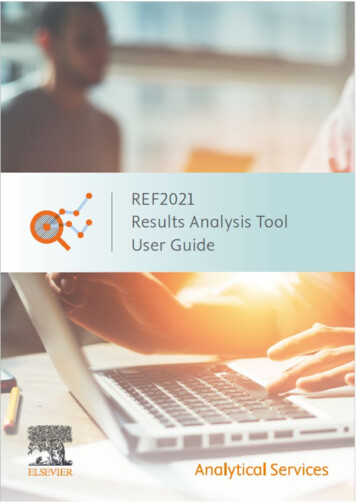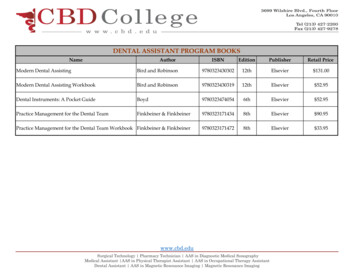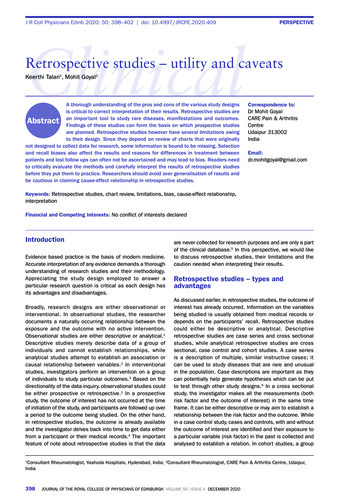
Transcription
CASE STUDIES: THE SYSTEM3INFORMATION IN THIS CHAPTER Security and SAM Hives System Hive Software Hive BCD HiveIntroductionWhen I sat down to write this book, I was aware that for mostfolks, providing spreadsheets, tables, and lists of Registry keysand values would not be an entirely effective means of communicating and sharing information about Registry analysis. Infact, after writing the first edition of Windows Forensic Analysis(Syngress Publishing, published in 2007, a.k.a., WFA), it waspretty clear to me that listing Registry keys and files wasn’t aseffective as providing examples of Registry analysis, and of howall of these could be used together. When I began writing thesecond edition of WFA, I specifically included a chapter on just“case studies,” in hopes of demonstrating how I and others haveused various data sources from a Windows system, in incidentresponse and forensic analysis scenarios, to gather informationand build an overall picture to solve the challenges we were facing. Talking with others, I can see how this can be an effectiveapproach leaving someone with stacks of lumber and roofing shingles and some tools and nails does not help his or herbuild a house. However, showing someone how a house can bebuilt, with some of the various places where modifications canbe made, is more of a “teach a man to fish” approach, and it canlead to more involvement in Registry analysis, in particular, andWindows forensic analysis as a whole.Windows Registry Forensics. DOI: 10.1016/B978-1-59749-580-6.00003-6 2011 Elsevier Inc. All rights reserved.85
86 Chapter 3CASE STUDIES: THE SYSTEMIn short, this chapter (and the one after it) will not be ac omprehensive list of all possible Registry keys and valuesthat would be of interest to an analyst, mapped against various types of examinations. Rather, we will take a look at someuse cases, as well as some scenarios that I and others haverun across, and problems that we’ve encountered and solved.My overall goal is to demonstrate how easily data from theRegistry can be extracted, and how it can be used to further anexamination.Security and SAM HivesThe first hives we’ll look at are the Security and SAM hives, inpart, because they have perhaps the least amount of data available (“pound for pound,” so to speak) compared with the Systemand Software hives. These hives contain some useful information, and there’s no question that what they can provide can beextremely valuable during an examination, but the data in theother two hives, in my experience, is both considerably moreexpansive and fluid.Data from the Security HiveAt the time of this writing, I am aware of little data that mightbe relevant to an examination that has been discussed publicly;however, there are a few keys and values that are of interest. Onesuch Registry key is “PolAcDms,” which was mentioned in theWikipedia page on security identifiers [1]. The “Default” valuewithin this key contains the security identifier (SID) for the system (or “machine”), which is a unique name that identifies anobject, and in this case, the system. As we will address later inthis chapter, this information can be used to determine whichusers on a system are local users, and which users are domainusers, which is something that can be very useful with respect toa domain-connected (as opposed to standalone) system and, inparticular, a system with multiple domain trusts. Parsing the SIDfrom the binary data is not an arduous task, and is included inthe RegRipper polacdms.pl plug-in, the output of which (whenrun against a Security hive extracted from a Vista system) isshown as follows:Launching polacdms v.20100531PolAcDmSPolicy\PolAcDmSLastWrite Time Fri Aug 31 15:14:53 2007 (UTC)
Chapter 3 CASE STUDIES: THE SYSTEM 87Machine SID: licy\PolPrDmSLastWrite Time Thu Nov 2 12:48:01 2006 (UTC)Primary Domain SID: S-1-5-Not only does this plug-in extract and parse the machineSID from the PolAcDmS key, but it also extracts and parses thedomain SID (for the domain to which the system was connected)from the PolPrDmS key. In this example, the Security hive wasextracted from a standalone system used by a home user. Ininstances where the system was connected to a domain, the primary domain SID can be parsed from the “Default” value of thatkey, and it will be visible following “Primary Domain SID:”. Laterin this chapter, we’ll discuss local user accounts found in theSAM hive, as well as the ProfileList key from the Software hive,and see how an analyst can use this information.The other key that is of use and interest to analysts fromthe Security hive is the “PolAdtEv” key. Parsing the binary dataretrieved from this value is not a trivial task. However, our understanding of how this data can be parsed and understood can behelped along with Microsoft (MS) KnowledgeBase (KB) article246120 [2]. As stated, this article applies to Windows NT 4.0, andthere are only seven areas of auditing listed in the article. However,Windows XP has nine areas of auditing, as illustrated in Figure 3.1.Figure 3.1 Audit Policy throughLocal Security Settings(Windows XP)
88 Chapter 3CASE STUDIES: THE SYSTEMIn order to view the information illustrated in Figure 3.1, allwe need to do is open the Administrative Tools Control Panelapplet and select the Local Security Policy shortcut. Another wayto view this information (one that is useful during live response,as it can be added to a batch file) is to run auditpol.exe; runningit on that same live system, the following can be observed:D:\tools auditpolRunning .(X) Audit EnabledSystem NoLogon NoObject Access NoPrivilege Use Success and FailureProcess Tracking NoPolicy Change NoAccount Management NoDirectory Service Access NoAccount Logon NoOkay, so that’s how we can extract the information from a livesystem, but what about from an acquired image? Using MS KBarticle 246120 as a basis and toggling various settings on andoff, we can see what modifications affect which areas of thedata, and develop an extrapolation of the data to our WindowsXP system. Or, the RegRipper plug-in auditpol.pl can be usedto extract and parse the necessary information, either as part ofa plug-ins file or run individually through rip.pl (or rip.exe), asshown below:Launching auditpol v.20080327auditpolPolicy\PolAdtEvLastWrite Time Mon Jul 12 18:09:46 2010 (UTC)Auditing is enabled.Audit System Events NAudit Logon Events NAudit Object Access NAudit Privilege Use S/FAudit Process Tracking NAudit Policy Change NAudit Account Management NAudit Dir Service Access NAudit Account Logon Events NThis information can be very valuable as it tells us a lot aboutthe state of auditing on the system at the time that an image was
Chapter 3 CASE STUDIES: THE SYSTEM 89acquired. First, the LastWrite time of the key lets us know whenthe settings were last modified (the time is listed in UniversalCoordinated Time, or UTC). This can be very helpful in understanding why we see, or don’t see, certain events in the EventLog, as well as provide an indication of when the audit policy waschanged. There’ve been a number of examinations where I’vecreated a time line and seen clearly when the incident occurred,and seen that as a result of response and remediation actionstaken by local IT staff, antivirus scans have been run and theaudit policy has been updated, just before an image was acquiredfrom the system.Next, we see whether or not auditing is enabled, and if so,which events are audited. This will also provide us with someindication of what we can expect to see in the Event Log. Forexample, if auditing of successful logon events isn’t enabled,then we wouldn’t expect to be able to see when someone loggedinto the system using a user account, either legitimately or as aresult of compromised credentials. I have used this information during examinations quite extensively; during one instance,I used the fact that auditing for both successful logins and failedlog-in attempts were both enabled, but there were no indicationsof remote logins through the Remote Desktop Protocol (RDP),to further illustrate that a particular user account had beenaccessed locally and used to view illegal images.It is important to note that while this key and value exist onWindows Vista and 7 systems, there has yet to be extensive testing on these systems. Figure 3.2 illustrates the audit policy on aWindows 7 Ultimate system.As you can see from Figure 3.2, there are nine areas of auditing listed, just as there are with Windows XP. In fact, the auditpolicies in Figures 3.1 and 3.2 look very similar. However, the“Default” value for the PolAdtEv key on Windows XP containsdata that is 44 bytes long, whereas on available Windows Vistaand 2008 systems, the data is 136 bytes long, and 138 bytes onavailable Windows 7 systems. So again, considerable testingTipIf successful, use of privilege events are being audited (i.e., Audit Privilege Use S) on a Windows XP system, and auser modifies the system time through the “Date and Time” Control Panel applet (this can also be done by right-clickingon the time display on the Task Bar and choosing “Adjust Date/Time”), an event ID 577 appears in the Security EventLog, indicating the use of the “SeSystemtimePrivilege” privilege.
90 Chapter 3CASE STUDIES: THE SYSTEMFigure 3.2 Audit Policy on a Windows 7 Ultimate Systemneeds to be performed in order to create a version of the auditpol.pl plug-in that works for Vista, as well as Windows 2008 andWindows 7.User Information from the SAM HiveMost administrators and analysts are aware that informationabout local users on a system is maintained in the SAM “database”or hive file. In corporate environments, the SAM hive may not havea great deal of useful information, but for environments where theusers will access systems using local accounts (home users, laptops, and so on), this hive file can provide a great deal of valuabledata. We’ll also see, later in this chapter, how the SAM hive can beused in other ways.TipAlthough information about user accounts local to the system are maintained in the SAM hive, the Software hive contains the ProfileList key (HKLM\Software\Microsoft\Windows NT\CurrentVersion\ProfileList), which is a list of all theprofiles on the system. This can show you remote or domain users who have logged into the system. We will discussthe ProfileList key later in this chapter.
Chapter 3 CASE STUDIES: THE SYSTEM 91The samparse.pl plug-in extracts both user and group information from the SAM hive. Most of the information specificto each user is available beneath the SAM\Domains\Account\Users\RID key for each user, where RID is four zeros followedby the user’s relative identifier (RID) in hexadecimal format.For example, the Administrator account has an RID of 500,which would appear as 000001F4 in the SAM, as illustrated inFigure 3.3.The key for each user contains at least two values, F (containsseveral time stamps, and so on) and V (contains user name,comment, and so on), which are binary data types and containinformation about the user account. I have relied heavily onthe source code for Peter Nordahl–Hagen’s ntpasswd utility [3]to understand and decode this data into something usable.Sometimes within the user’s key, you will also find a value nameFigure 3.3 Windows XP SAM Keys through RFV
92 Chapter 3CASE STUDIES: THE SYSTEM“UserPasswordHint,” which contains a string value if a user hasentered a password hint.An excerpt of the user information extracted from the F andV values in the SAM hive by the samparse.pl RegRipper plug-inappears as follows:User Information------------------------Username: Administrator [500]Full Name:User Comment: Built-in account for administering thecomputer/domainAccount Created : Tue Sep 11 14:26:13 2007 ZLast Login Date : Fri Aug 31 15:52:42 2007 ZPwd Reset Date : Thu Nov 2 13:09:52 2006 ZPwd Fail Date : NeverLogin Count: 4-- Password does not expire-- Account Disabled-- Normal user accountUsername: Guest [501]Full Name:User Comment: Built-in account for guest access to thecomputer/domainAccount Created : Tue Sep 11 14:26:13 2007 ZLast Login Date : NeverPwd Reset Date : NeverPwd Fail Date : NeverLogin Count: 0-- Password does not expire-- Account Disabled-- Password not required-- Normal user accountUsername: Harlan [1000]Full Name:User Comment:Account Created : Tue Sep 11 14:26:01 2007 ZPassword Hint: usual plus a bit moreLast Login Date : Mon Jan 12 12:41:35 2009 ZPwd Reset Date : Tue Sep 11 14:26:02 2007 ZPwd Fail Date : Fri Jul 11 19:54:07 2008 ZLogin Count: 16-- Password does not expire-- Password not required-- Normal user accountAs you can see, a great deal of information is available inthe user’s keys within the SAM. This information can be used
Chapter 3 CASE STUDIES: THE SYSTEM 93to demonstrate activity on the system (i.e., Last Login Date,Login Count values) for a specific user account, as well as tellyou a number of other things, such as if the Guest account hasbeen enabled and used. Another tell-tale sign of unusual activity would be if accounts such as the support or HelpAssistantaccounts have been enabled.Note that in the output excerpt above, the “Harlan” useraccount has an extra field that the other two do not; specifically,“Password Hint.” Many Windows systems (including Windows XP)allow the option to add a password hint to the user account, asillustrated in Figure 3.4.Figure 3.4 Add a Password Hint to a Windows 7 User AccountTipOf particular note in the output of the samparse.pl plug-in is the entry for “Password not required.” In some cases, analysts have taken this flag value to mean that the account does not have a password, and that is not the case.Rather, it means that password policies (length, complexity, and so on) applied to the user accounts on the system donot apply to those accounts for which the “Password not required” flag is set. I had posed the question to someoneknowledgeable in this area, and had been informed, “That specifies that the password-length and complexity policysettings do not apply to this user. If you do not set a password, then you should be able to enable the account andlogon with just the user account. If you set a password for the account, then you will need to provide that password atlogon. Setting this flag on an existing account with a password does not allow you to logon to the account without thepassword.” This is somewhat supported by MS KB article 305144 [4], which indicates that enabling the flag means thata password is not required.
94 Chapter 3CASE STUDIES: THE SYSTEMThere have been several cases where a somewhat careless userhas added something odd to his or her password hint, and it hasturned out to be the user’s password!THE CASE OF THE DISAPPEARING USER ACCOUNTI was examining an image sent to me, looking for indications of malicious activity. As is often the case, I neither had a really goodidea of the specific activity of interest, nor of the time frame in question. I had created a time line of activity on the system, using thefile system metadata, Prefetch file metadata, Event Log record data,and so on, as sources, and had started to see some unusual activity.In one instance, I found that a particular user account had logged inabout a year before the image had been acquired, but I didn’t findany indication of that user account in the SAM. I used regslack.exeto extract deleted keys and values, and unallocated space from theSAM hive, and found an account with the same RID as the accountI was interested in, but in the deleted data, the key had a differentuser name associated with it. I also noted that the LastWrite time onthe deleted key was very close to the time that the image of the system had been acquired. As it turned out, a system administrator hadlogged into the system, changed the name on the account when heor she heard that “someone was coming to acquire the system,” andthen deleted the account. This was confirmed by that same systemadministrator.The samparse.pl plug-in will also extract information aboutlocal groups from the SAM hive, including the group name, comment, and the SIDs for the users in the group. An excerpt of thisoutput from a Windows XP system is illustrated below:Group Name: Users [4]LastWrite : Thu Sep 13 12:35:14 2007 ZGroup Comment : Users are prevented from making accidentalor intentional system-wide changes. Thus, Users can runcertified applications, but not most legacy applicationsUsers 003Group Name: Guests [1]LastWrite : Fri Jan 19 00:58:18 2007 ZGroup Comment : Guests have the same access as members of theUsers group by default, except for the Guest account whichis further restrictedUsers :S-1-5-21-11123406-2312686674-711150868-501
Chapter 3 CASE STUDIES: THE SYSTEM 95Group Name: Remote Desktop Users [0]LastWrite : Mon Apr 4 18:34:48 2005 ZGroup Comment : Members in this group are granted the rightto logon remotelyUsers : NoneGroup Name: Administrators [6]LastWrite : Thu Sep 13 12:35:14 2007 ZGroup Comment : Administrators have complete and unrestrictedaccess to the computer/domainUsers 1279470122-37504As you can see from the sample output from the samparse.plplug-in, there are a number of users (both local and domainusers) in the Administrators group, while other groups (i.e.,Guests) have few users, and still others (i.e., Remote Users)have none. This information can be very helpful in determiningthe level of access that a particular user account had on a system at the time that system was acquired, in order to determinewhat actions that user could take on the system, such as submit Scheduled Tasks (which is one way that a user could obtain elevated privileges), and so on.Also, the samparse.pl plug-in is very convenient as it allowsyou to obtain and view a great deal of local user and group information from a system, all in one easy-to-reference location.Cracking User PasswordsThere are a number of times during investigations when youwould want to determine a user’s password. For example, in anumber of examinations, law enforcement officials have wantedto know if the user account had a password at all. In mostinstances, I have seen this sort of query associated with caseswhere something suspicious (or illegal) is associated with theuser account of another family member, and law enforcementofficials want to determine if the suspect had free access to thataccount; an account with no password is extremely vulnerable. Inother cases, the “Password not required” flag in the user accountsettings (mentioned earlier in this chapter) can be very confusing to some analysts, and determining if the user account had apassword at all, and attempting to determine what that passwordis, is paramount to the investigation. Finally, there may be a time
96 Chapter 3CASE STUDIES: THE SYSTEMTipThere are two types of password hashes stored in the SAM database: LM (LAN Manager [9]) and NTLM (NT LANManager [10]). However, administrators can prevent LM hashes from being stored in the Active Directory and local SAMdatabases [11], as the LM hash has long been known to be relatively weak in comparison with the NTLM hash and isprone to fast brute force attacks in decrypting them. On Windows XP and 2003 systems, setting the NoLMHash value to1, or creating a password longer than 15 characters, disables storing of the LM hash.during an investigation where, after you’ve acquired an image ofthe system, you may want to boot the system (either the originalsystem or the acquired image, which can be “booted” in a virtualenvironment through LiveView [5], in order to “see” what the usersaw or had access to while he or she had logged into the system.In order to crack the passwords, the first thing we need to dois to get the hashes. In order to do so, extract the SAM and Systemhives from the acquired image to a suitable location (as part ofmy case management, I tend to create specific subdirectoriesbeneath my main case directory just for this purpose). There area couple of ways to go about obtaining the hashes from these twofiles (the System hive is required as the passwords are protectedwith an additional layer of encryption called “SysKey” [6]). To getthe hashes, you can use either pwdump7 [7] or Cain [8].To obtain the password hashes using pwdump7, download andextract the tool files, and then open a command prompt to thedirectory where the tool is located. It is important to note that running pwdump7 with no arguments will extract the password hashesfrom your analysis system; this is generally not a “good thing.” Inorder to get the password hashes from the System and SAM hivefiles you extracted from an acquired image, use the “–s” switch:D:\tools pwdump7 –s sam hive system hive Note that the order of the arguments in the command isimportant. Also important is to ensure that you use the full andcorrect paths to the hive files, even if they are located in the samedirectory as pwdump7.exe, as the program does not prepend thearguments with the path of the current working directory. Notonly do you need to do this so that the program knows wherethe files are located and can open them, but also to ensure thatyou’re using the SAM and System hive files from the same case;mixing the two (using a SAM hive from one case and a Systemhive from another case) generally results in something not working properly, if at all.
Chapter 3 CASE STUDIES: THE SYSTEM 97Using the SAM and System hive files from a test case (the“hacking case” available from NIST [12]), we run the followingcommand:D:\tools pwdump7 -s d:\case\sam d:\case\systemThis gives us the following output 31D6CFE0D16AE931B73C59D7E0C089C0:::Mr. 3C59D7E0C089C0:::In this example, I’ve removed a couple of the user accountsand only illustrated the ones of most interest to us in this case. Asyou can see, the output includes the user name, relative identifier (RID), LM hash, and the NTLM hash. This format allows usto easily import these hashes into password-cracking tools; however, as shown in the excerpt, neither of the two accounts has apassword. This simple tool can provide a great deal of valuableinformation to the analyst, particularly, in cases where knowingwhether or not an account has a password is pertinent.There are also a number of free, GUI-based password-crackingtools available, such as Cain & Abel, OphCrack [14], and Johnthe Ripper. There are also for-fee tools such as SAMInside [15],for which there is a limited demo version available. For the “oldtimers” in the information security industry, L0phtCrack version6 [16] is also available for a fee, and with a 15-day trial period. Itisn’t necessary to go through all of these tools, as this is beyondthe scope of the book, and the programs are quite easy to use;instead, we’ll just take a look at how to use Cain & Abel andOphCrack.To use Cain (we won’t be using the “Abel” functionality), download, install, and launch the program. From the Tools menu, selectthe Syskey Decoder entry, as illustrated in Figure 3.5.TipBooting an image through LiveView (see the appropriate sidebar later in this chapter) can let you verify the finding that auser account has no password. With respect to the NIST hacking case, booting the image in a virtual machine causes itto log directly into the Mr. Evil user account. This is controlled by the DefaultUserName value in the WinLogon key, perMS KB article 315231 [13]. In this case, the user account has no password, so there is no DefaultPassword value listedin the Registry. If there were, it would be in plain text, which is why the MS KB article states several times that whenusing these values, the system itself should be physically secure.
98 Chapter 3CASE STUDIES: THE SYSTEMFigure 3.5 Selecting Syskey Decoder In Cain Tools MenuFigure 3.6 Boot Key SelectedWhen the Syskey Decoder dialog appears, select the buttonwith the three dots in the “Boot Key (HEX)” box and navigate tothe System hive that you extracted from the image. Once the fileis selected, click Open in the Open dialog, and the “boot key” willappear in the text field, as illustrated in Figure 3.6.Selected the boot key and hit Ctrl-C, copying the boot key tothe clipboard, and then click the Exit key in the Syskey Decoderdialog. Next, in the main Cain window, click the Cracker tab, andthen highlight “LM & NTLM Hashes” in the left-hand pane, asillustrated in Figure 3.7.Now, click the blue plus sign that is located directly above theSniffer tab. If the plus sign is grayed out, try clicking on NTLMv2
Chapter 3 CASE STUDIES: THE SYSTEM 99Figure 3.7 Cain Cracker Tab SelectedFigure 3.8 “Add NT Hashes from” Dialog in CainFigure 3.9 Hashes Populating Cracker PaneHashes entry in the left-hand pane, and then back on the LM &NTLM Hashes entry. In the “Add NT hashes from” dialog, clickthe Import hashes from a SAM database radio button, andthen paste the boot key (from the clipboard) into the “Boot Key”text field. Click the button with the three dots next to the “SAMFilename” text field and navigate to the SAM hive, as illustrated inFigure 3.8.Click on Next in the “Add NT Hashes from” dialog, and theCracker pane in Cain gets populated with the LM and NTLMhashes for each user account, as illustrated in Figure 3.9.
100 Chapter 3CASE STUDIES: THE SYSTEMWe used the same SAM and System hive files as we used withthe pwdump7.exe example previously in this chapter, so it shouldbe no surprise that the LM Passwords for the Administrator andMr. Evil user accounts are listed as “*empty*”. In fact, this is excellent validation of our previous findings.At this point, in order to attempt to crack the password foran account, right-click on a user account, and select the type ofpassword-cracking attack you would like to use, as illustrated inFigure 3.10.Installing OphCrack (version 3.3.1 at the time of this writing)is a bit different and perhaps a bit more involved than using Cain.Download and install the application, and then be sure to followthe application instructions for downloading and installing thenecessary rainbow tables (also available from the Sourceforge.netsite; other tables can also be found elsewhere on the Internet).For the purposes of this example, the “XP Free Fast” tables wereinstalled.To begin, open OphCrack and click the Load button, and thenselect the Encrypted SAM option, as illustrated in Figure 3.11.When the Browse for Folder dialog appears, navigate to thedirectory where the SAM and System hives that you extractedfrom your acquired image are located. Once you’ve selected thedirectory and clicked OK, the Progress tab will be populated withthe password hashes, as illustrated in Figure 3.12.As you can see, the NTLM hashes for the Administrator andMr. Evil user accounts are also listed as “empty” by OphCrack.Figure 3.10 Selecting a Password-Cracking Attack
Chapter 3 CASE STUDIES: THE SYSTEM 101Figure 3.11 OphCrack, Load Encrypted SAM OptionFigure 3.12 Password Hashes In OphCrack Progress TabAt this point, if we had user accounts with passwords, and wewanted to attempt to crack them, all we’d need to do is click theCrack button (see Figure 3.12).Again, a detailed discussion of password-cracking attacks orof the Cain or OphCrack applications is beyond the scope of thisbook. My purpose in providing the information about the toolsin this chapter has been to illustrate how freeware tools can beused to derive (and validate) information from Registry hivefiles; in this case, to illustrate information about user accountsextracted from the SAM database, and to validate whether or not
102 Chapter 3CASE STUDIES: THE SYSTEMa user account actually has a password associated with it thatneeds to be typed in by a user. As I mentioned earlier, simplydetermining whether or not an account has a password has beena very important part of a number of examinations.BOOTING AN ACQUIRED IMAGE WITH LiveViewSometimes during an examination, you may want to “see” what the usersaw when they logged into the system. However, if all that is availableto you is an acquired image, how can you do this? Well, you can useLiveView to boot the acquired image, but you would still need valid usercredentials to log into the system. So, what do you do if you don’t havevalid credentials for a user account on the system? Actually, it’s not allthat hard you just have to be quick.Before we begin, make sure that you’ve made a copy of the acquiredimage if something should go wrong, we don’t want to lose our onlysource of data. Start by first downloading LiveView, and then downloading the bootable CD release of Peter Nordahl–Hagen’s ntpasswd utility.As of this writing, the file you’re looking for is named “cd100627.zip”;download this file and extract the ISO file from the archive. Follow theLiveView instructions for creating a bootable virtual machine (VM) fromthe acquired image, and then point the CD player in the VM to the ISOimage of the ntpasswd utility. Start the VM, and as the system boots, hit F12to interrupt the boot sequence. This may take a couple of attempts thefirst time I tried it, I didn’t successfully access the BIOS until the fourthattempt. Once you do interrupt the boot sequence and access the BIOS,tell the BIOS to boot off of the CD first, save the settings and reboot thesystem. When it comes back up, follow the ntpasswd utility prompts andchange the Administrator password. Once you’ve successfully changedthe password, shut the system down, disconnect th
Audit Logon Events N Audit Object Access N. Audit Privilege Use S/F Audit Process Tracking N. Audit Policy Change N Audit Account Management N. Audit Dir Service Access N Audit Account Logon Events N. This information can be very valuable as it tells us a lot about the state of auditing on the system at the time that an image was .











